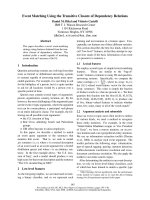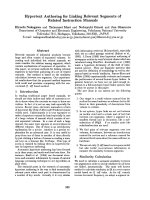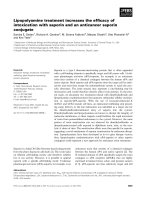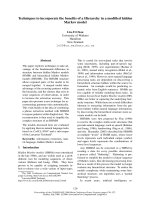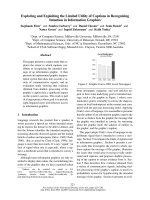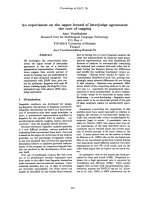Báo cáo khoa học: "Neuromuscular deterioration in the early stage of sepsis in rats" ppt
Bạn đang xem bản rút gọn của tài liệu. Xem và tải ngay bản đầy đủ của tài liệu tại đây (512.95 KB, 7 trang )
Open Access
Available online />Page 1 of 7
(page number not for citation purposes)
Vol 11 No 1
Research
Neuromuscular deterioration in the early stage of sepsis in rats
Ilkin Cankayali
1
, Yusuf Hakan Dogan
2
, Ilhami Solak
3
, Kubilay Demirag
1
, Oguz Eris
1
,
Serdar Demirgoren
2
and Ali Resat Moral
1
1
Department of Anaesthesiology and Intensive Care Unit, Ege University, School of Medicine 35100, Izmir, Turkey
2
Department of Physiology, Ege University, School of Medicine 35100, Izmir, Turkey
3
Department of General Surgery, Ege University, School of Medicine 35100, Izmir, Turkey
Corresponding author: Ilkin Cankayali,
Received: 20 Jan 2006 Revisions requested: 21 Feb 2006 Revisions received: 1 Sep 2006 Accepted: 4 Jan 2007 Published: 4 Jan 2007
Critical Care 2007, 11:R1 (doi:10.1186/cc5139)
This article is online at: />© 2006 Cankayali et al.; licensee BioMed Central Ltd.
This is an open access article distributed under the terms of the Creative Commons Attribution License ( />),
which permits unrestricted use, distribution, and reproduction in any medium, provided the original work is properly cited.
Abstract
Introduction Critical illness polyneuropathy (CIP) is a clinical
condition frequently seen in patients being treated in critical
care units in the final stage of sepsis. The etiopathology of CIP
is still unclear, and the onset time of appearance of the
electrophysiological findings has not been elucidated. The very
little research that has been carried out on this topic is limited to
clinical electrophysiological and histopathological studies. In
this study, electrophysiological alterations in the early stage of
experimentally induced sepsis were investigated in septic rats.
Methods We conducted a prospective, randomized, controlled
experimental study in an animal basic science laboratory with 30
male Sprague-Dawley rats, weighing 200 to 250 g. All of the
rats were randomly assigned to one of two groups. In the sepsis
group (n = 20), cecal ligation and puncture (CLP) was
performed to induce experimental sepsis. In the sham-operated
group (n = 10), laparotomy without CLP was performed. Before
and 24 hours after CLP and laparotomy, the right sciatic nerve
was stimulated from the sciatic notch and compound muscle
action potentials (CMAPs) were recorded from the
gastrocnemius muscle. Recordings of latency, amplitude, and
duration of the CMAP were evaluated.
Results CMAP durations before and 24 hours after surgery
were 0.45 ± 0.05 ms and 0.48 ± 0.05 ms, respectively, in the
sham-operated group and 0.46 ± 0.05 ms and 0.55 ± 0.01 ms,
respectively, in the sepsis group. Latency measurements in the
sham-operated group were 0.078 ± 0.010 ms and 0.080 ±
0.015 ms, respectively, whereas measurements were found to
be prolonged in the sepsis group: 0.094 ± 0.015 ms and 0.149
± 0.054 ms before and 24 hours after surgery, respectively (p <
0.05). CMAP amplitudes in the sham-operated group before
and 24 hours after surgery were 8.41 ± 0.79 mV and 8.28 ±
1.92 mV, respectively, whereas in the sepsis group the
amplitude measurements decreased to 7.60 ± 1.75 mV and
4.87 ± 3.44 mV, respectively (p < 0.05).
Conclusion The results of the study indicate that
electrophysiological alterations appear in the first 24 hours after
experimental sepsis and are characterized by an increase in
latency and a decrease in CMAP amplitude. The results also
suggest that electrophysiological findings seen in patients with
CIP might appear before clinical signs of CIP.
Introduction
Critical illness polyneuropathy (CIP) was described as a clini-
cal disorder by Bolton and colleagues [1] in 1984. It is a pri-
mary axonal degeneration of motor and sensory fibers which
occurs mostly in patients who have systemic inflammatory
response syndrome (SIRS), sepsis, or multiple organ dysfunc-
tion syndrome (MODS) [2-7]. Berek and colleagues [8] sug-
gested that, in the course of sepsis, CIP has to be considered
part of MODS.
CIP manifests with general weakness and sensory defects and
especially with weakness of the respiratory muscles, leading
to problems in weaning from mechanical ventilation in the
intensive care unit (ICU). Physiopathology, onset of the symp-
toms, and the treatment of CIP have not been clearly defined.
The studies on CIP are based mostly on clinical manifestations
and neurophysiological research. However, an experimental
study investigating possible neuromuscular changes in the
CIP = critical illness polyneuropathy; CLP = cecal ligation and puncture; CMAP = compound muscle action potential; EMG = electromyelographic;
ICU = intensive care unit; MODS = multiple organ dysfunction syndrome; SIRS = systemic inflammatory response syndrome.
Critical Care Vol 11 No 1 Cankayali et al.
Page 2 of 7
(page number not for citation purposes)
early stage of sepsis has not been performed yet. We aimed
to observe electrophysiological alterations in the early stage of
sepsis. In this study, an experimental sepsis model was per-
formed to investigate electrophysiological alterations in the
first 24 hours of sepsis.
Materials and methods
Animal Ethics Committee approval was obtained, and the
study was conducted in the Research Laboratory of the
Department of Anesthesiology and ICU of Ege University Med-
ical School (Izmir, Turkey).
Experimental procedures
Thirty adult male Sprague-Dawley rats two to three months
old, each weighing approximately 250 g, were used. All rats
were housed in cages one week before the experiments in an
acclimatized room at standard room temperature and with
twelve hour light/dark cycles. Rats were allowed free access
to water and standard chow. For surgical intervention, rats
were anesthetized with ketamine (80 mg/kg) and xylazine (10
mg/kg) given intraperitoneally.
All rats were randomly divided into one of two groups: a cecal
ligation and puncture (CLP)-operated group (sepsis group) (n
= 20) and a sham-operated group (sham group) (n = 10). Due
to the sepsis model's high mortality rate, more rats were
grouped in the sepsis group (n = 20) than in the sham group
(n = 10). For reliable statistical results, at least six rats is suffi-
cient. We decided to perform the study with at least 10 rats.
Sepsis was induced by CLP performed as described previ-
ously [9,10]. In this sepsis model, five hours after CLP, rats
were accepted as septic. Under aseptic conditions, a 3-cm
midline laparotomy was performed to allow exposure of the
cecum with adjoining intestine. The cecum was ligated tightly
with a 3.0 silk suture at its base below the iliocecal valve and
perforated once with a 22-gauge needle. The cecum was then
gently squeezed to extrude a small amount of feces from the
perforation site. The cecum was returned to the peritoneal cav-
ity, and the laparotomy incision was closed with 4.0 silk
sutures. In the sham group, under aseptic conditions only,
laparotomy was performed on rats, but their cecum was nei-
ther ligated nor punctured.
Measurements and calculations
Electrophysiological recordings were obtained from the right
sciatic nerve stimulated supra-maximally (intensity 10 V, dura-
tion 0.1 ms, frequency 1 Hz) by a Biopac HSTM01 surface
stimulation electrode (BIOPAC Systems, Inc., Santa Barbara,
CA, USA) from the sciatic notch, and compound muscle
action potentials (CMAPs) were recorded by means of super-
ficial disc electrodes located over the gastrocnemius muscle
before and 24 hours after surgery. Data were evaluated using
Biopac Student Lab Pro version 3.6.7 software (BIOPAC Sys-
tems, Inc.), with latency, amplitude, and duration of CMAP as
the parameters (Figures 1, 2, 3, 4). During the electromyelo-
graphic (EMG) recordings, rectal temperatures of the rats
were monitored by a rectal probe (HP Viridia 24-C; Hewlett-
Packard Company, Palo Alto, CA, USA) and the temperature
of each rat was kept at approximately 36°C to 37°C by heating
pad. The animals were euthanized 24 hours after the CLP for
the next recording.
Because we aimed to assess EMG recordings in the early
stage of sepsis, we obtained EMG recordings of the rats in the
first 24 hours after CLP. We did not aim to observe clinical
signs of sepsis; therefore, the animals were euthanized 24
hours after surgery.
Statistical analysis
The results were analyzed with the SPSS ver 14.0 statistical
program (SPSS Inc., 233 South wacker Drive, 11
th
floor, Chi-
cago, IL 60606-6307) by using repeated measures (analysis
of variance). Factors were session (before and 24 hours after
surgery) and treatment (sepsis and sham groups). Dependent
variables were latency, amplitude, and duration. The groups
were compared by paired-sample t test, and results were
given as mean ± standard deviation. A value of p > 0.05 was
accepted as statistically significant.
Results
In the sepsis group, five rats died during the first 24 hours and
were excluded from the study. At 24 hours, the mortality rate
was 25% in the sepsis group, and there was no mortality in the
sham group. The mortality rate was high in the sepsis group
because we did not use treatment materials (antibiotics and
fluid resuscitation) for this study.
CMAP durations before and 24 hours after surgery were
recorded as 0.45 ± 0.05 ms and 0.48 ± 0.05 ms, respectively,
in the sham group. Statistically significant difference was not
found (p > 0.05). CMAP durations before and 24 hours after
surgery were recorded as 0.46 ± 0.05 ms and 0.55 ± 0.01
ms, respectively, in the sepsis group. Statistically significant
difference was found in CMAP duration only for session (F
1,23
= 7.49, p = 0.012) but not for treatment (F
1,23
= 4.02, p =
0.057) (p > 0.05) (Table 1). CMAP amplitudes in the sham
group before and 24 hours after surgery were 8.41 ± 0.79 mV
and 8.28 ± 1.92 mV, respectively. Statistically significant dif-
ference was not found (p > 0.05) (Table 1). However, in the
sepsis group, the amplitudes decreased from 7.60 ± 1.75 mV
to 4.87 ± 3.44 mV. This alteration was statistically significant
(p < 0.05) (Table 1). CMAP amplitudes in the sham group
were not different statistically but session (F
1,23
= 5.56, p =
0.027) and treatment (F
1,23
= 8.40, p = 0.008) were signifi-
cantly interacted (F
1,23
= 4.38, p = 0.047) and the effect was
observed only in the sepsis group (Table 1). Whereas CMAP
amplitudes decreased profoundly in the sepsis group (ratio of
the prolonged time = -33.3%), CMAP amplitudes were much
Available online />Page 3 of 7
(page number not for citation purposes)
less decreased in the sham group (ratio of the prolonged time
= -0.7%).
Latency measurements were not significantly altered in the
sham group (from 0.078 ± 0.010 ms to 0.080 ± 0.015 ms),
whereas measurements were found to be prolonged in the
sepsis group (from 0.094 ± 0.015 ms to 0.149 ± 0.054 ms)
before and 24 hours after surgery, respectively (p < 0.05).
Latency data showed significant difference only in the sepsis
group, and interacted for session (F
1,23
= 13.47, p = 0.001)
and treatment (F
1,23
= 15.86, p = 0.001) (F
1,23
= 11.98, p =
0.002). Whereas latency time was prolonged in the sepsis
group in a significant manner (ratio of the prolonged amount =
56.45%), latency time was prolonged much less in the sham
group (ratio of the prolonged amount = 2.4%) (Table 1).
CMAP duration and latency increase and CMAP amplitude
decrease in the sham group was not statistically significant (p
> 0.05).
Discussion
CIP is a neuromuscular pathology regarded as a neurological
complication of sepsis given that CIP may have always accom-
panied sepsis [3-6,8,11,12]. Underlying primary illness or the
type of trauma, metabolic disorders, hypoxia, nutritional defi-
ciencies, and medications such as antibiotics, neuromuscular
blocking agents, and corticosteroids are insufficient to reveal
the potential causes of CIP [2,4]. However, etiology, patho-
genesis, time of onset, preventive measures, and therapy of
CIP are still controversial and could not be defined clearly. In
patients with sepsis and SIRS, the seriousness of the underly-
ing disease and treatments with neuromuscular drugs and opi-
oids and mechanical ventilation may conceal the onset and
symptoms of CIP and may delay the diagnosis of CIP. There-
fore, electrophysiological examination is the most important
tool in the early diagnosis and course of CIP [2,13]. But the
muscle fibrillation potentials and positive sharp waves cannot
be observed before three weeks of sepsis. Otherwise, the
latency changes that are accepted as typical for axonal dam-
age and the decrease of the motor action potential (CMAP)
amplitude may appear in the first week of sepsis. They are
regarded as the earliest electrophysiological signs of CIP.
Despite denervation, signs have been found on the fifth day; in
some studies, spontaneous EMG activity cannot be expected
before the 10
th
or 14
th
day of acute denervation [14]. In the
electrophysiological research of Tennila and colleagues [15],
CMAP amplitudes of median and ulnar nerves were found to
be decreased on the fifth day in nine mechanically ventilated
patients with SIRS and/or MODS. In addition, abnormal spon-
taneous activities such as sharp positive waves and fibrillation
potentials were found to be present in EMG recordings in their
clinical series.
Figure 1
A sample of compound muscle action potential recorded before laparotomy in the sham groupA sample of compound muscle action potential recorded before laparotomy in the sham group. EMG, electromyelograph.
Critical Care Vol 11 No 1 Cankayali et al.
Page 4 of 7
(page number not for citation purposes)
Figure 2
A sample of compound muscle action potential recorded 24 hours after laparotomy in the sham groupA sample of compound muscle action potential recorded 24 hours after laparotomy in the sham group. EMG, electromyelograph.
Figure 3
A sample of compound muscle action potential recorded before cecal ligation and puncture in the sepsis groupA sample of compound muscle action potential recorded before cecal ligation and puncture in the sepsis group. EMG, electromyelograph.
Available online />Page 5 of 7
(page number not for citation purposes)
In this study, CMAP amplitude was decreased; regarding the
first electrophysiological finding in the early phase of CIP
[2,6,16] and marked prolongation of latency values appeared
in the first 24 hours of sepsis. Our findings are supported by
the previous studies. In some earlier studies, it was postulated
that decrease in the CMAP amplitude was due primarily to
neuromuscular blocking agents, steroids, and some medica-
tions used widely in ICUs [4,17-19]. However, the latest pro-
spective studies have shown that there is no correlation with
CIP, critical illness myopathy, and medication used [5,6,20]. In
the present study, the neurophysiological conduction altera-
tions were seen in the experimental CIP model without using
neuromuscular blocking agents and/or steroids. Therefore,
these findings support the concept that sepsis is mainly
responsible for the neuromuscular changes. Likewise, antibiot-
ics, especially aminoglycosides and their metabolites, are said
to be the other factors responsible for development of CIP that
results from the increase of capillary membrane permeability
and the invasion of antibiotics to peripheral nerves in sepsis
[21]. However, there is no statistical evidence confirming
these opinions, and thus further studies are needed. Given
that antibiotics were not used in our experimental sepsis
model, our results support the idea that the observed electro-
physiological alterations were attributable entirely to sepsis.
Disturbances in microcirculation and autoregulation of periph-
eral nerves, as well as the other organs influenced in sepsis,
are thought to be the principal causes of the development of
CIP. In addition, cytokines released in sepsis also cause an
increase in capillary permeability due to a histamine-like effect
and the resulting endoneural edema leads to hypoxia and
energy deficit by increasing the intercapillary space [2].
Figure 4
A sample of compound muscle action potential sample recorded 24 hours after cecal ligation and puncture in the sepsis groupA sample of compound muscle action potential sample recorded 24 hours after cecal ligation and puncture in the sepsis group. EMG,
electromyelograph.
Table 1
Measurements of compound gastrocnemius muscle action potentials
CMAP duration (ms) CMAP amplitude (mV) Latency (ms)
Groups Before surgery 24 hours after surgery Before surgery 24 hours after surgery Before surgery 24 hours after surgery
Sepsis group 0.46 ± 0.05 0.55 ± 0.01 7.60 ± 1.75 4.87 ± 3.44
a
0.094 ± 0.015 0.149 ± 0.054
a
Sham group 0.45 ± 0.005 0.48 ± 0.05 8.41 ± 0.79 8.28 ± 1.92 0.078 ± 0.010 0.080 ± 0.015
a
p < 0.05. All values are presented as mean ± standard deviation for each group. CMAP, compound muscle action potential.
Critical Care Vol 11 No 1 Cankayali et al.
Page 6 of 7
(page number not for citation purposes)
Because the axonal transportation of structural proteins is
highly energy-dependent, this energy deficit induces primary
axonal degeneration of distal nerves [2]. Bolton and col-
leagues [3] suggested that tumor necrosis factor, arachidonic
acid, and metabolites of histamine, complement activation,
cellular adhesion systems, and free radicals were principal fac-
tors responsible for systemic effects of sepsis and SIRS and
these factors might lead to primary axonal degeneration.
Electrophysiological measurements in the early studies
obtained during early periods of clinical sepsis indicated that
the decrease in amplitude of CMAP was accompanied by an
increase in duration without any change in latency. This finding
directed attention to the muscle fiber membrane as a physio-
pathological explanation [22]. Decrease in CMAP amplitude
and increase in duration were suggested to be secondary to
the dysfunction of energy-dependent sodium-potassium
pumps in muscles [23]. In the present study, although there
was an increase in the duration 24 hours after sepsis was
induced, the difference was not statistically significant when
compared with the sham group. Our results do not show the
prolongation of duration which has been shown in the previous
studies, due to electrophysiological data that were obtained in
the early stages (24 hours) of sepsis in this study. The
prolongation of the duration due to sodium-potassium pump
insufficiency in the muscles has been accepted as an indicator
observed in the later stages of sepsis. Our results indicate no
change in CMAP duration but a decrease in amplitude and
observable prolongation of the latency which is regarded as an
indicator of axonal degeneration. Further detailed studies
should be designed to elucidate the pathogenesis properly.
The common point in the majority of the related articles is the
presence of a decrease of CMAP amplitude. CMAP is pro-
duced by synchronized activation of the muscle fibers after
axonal innervations, which is the sum of the responses of the
striated muscles to stimuli. In addition, CMAP is a valuable tool
both for evaluating to descending motor axon and the
response of the muscle fibers to the stimulus placed distally
and the conduction at the neuromuscular junction [24]. In this
study, CMAP changes indicate possible axonal conduction
and/or neuromuscular junction pathologies or a reduced
number of fibers responding to stimulus. But we were not able
to distinguish and define the origin of the observed changes
such as axonal conduction defects, neuromuscular junction
pathologies, or reduction of the number of the muscle fibers
that led to the decrease of the amplitude and prolongation of
CMAP in the sepsis group.
Conclusion
Our results indicate that electrophysiological findings
appeared in the first 24 hours after experimental sepsis and
were characterized by an increase in latency and a decrease
in CMAP amplitude. Therefore, we conclude that electrophys-
iological changes seen in sepsis might appear before clinical
signs of CIP.
Competing interests
The authors declare that they have no competing interests.
Authors' contributions
IC, IS, and ARM designed the study. IC, YHD, IS, KD, OE, and
ARM coordinated the study and drafted the manuscript. IC,
YHD, and IS collected data. IC, IS, YHD, KD, OE, SD, and
ARM helped to draft the manuscript. IC, YHD, IS, and ARM
conceived and designed the study and performed the statisti-
cal analysis. All authors read and approved the final
manuscript.
References
1. Bolton CF, Gilbert JJ, Hahn AF, Sibbald WJ: Polyneuropathy in
critically ill patients. J Neurol Neurosurg Psychiatry 1984,
47:1223-1231.
2. Zochodne DW, Bolton CF, Wells GA: Critical illness polyneu-
ropathy. A complication of sepsis and multiple organ failure.
Brain 1987, 110:819-841.
3. Bolton CF: Sepsis and the systemic inflammatory response
syndrome: neuromuscular manifestations. Crit Care Med
1996, 24:1408-1416.
4. Witt NJ, Zochodne DW, Bolton CF: Peripheral nerve function in
sepsis and multiple organ failure. Chest 1991, 99:176-184.
5. Leijten FS, de Weerd AW: Critical illness polyneuropathy. A
review of the literature, definition and pathophysiology. Clin
Neurol Neurosurg 1994, 96:10-19.
6. Zifko UA, Zipko HT, Bolton CF: Clinical and electrophysiological
findings in critical illness polyneuropathy. J Neurol Sci 1998,
159:186-193.
7. Motomura M: [Critical illness polyneuropathy and myopathy.]
(Abstract). Rinsho Shinkeigaku 2003, 43:802-804.
8. Berek K, Margreiter J, Willeit J: [Polyneuropathy in the critically
ill patient – critical illness polyneuropathy.] (Abstract). Wien
Klin Wochenschr 1998, 110:243-252.
9. Otero-Anton E, Gonzalez-Quintela A, Lopez-Soto A, Lopez-Ben S,
Llovo J, Perez LF: Cecal ligation and puncture as a model of
sepsis in the rat: influence of the puncture size on mortality,
bacteremia, endotoxemia and tumor necrosis factor alpha
levels. Eur Surg Res 2001, 33:77-79.
10. Ritter C, Andrades M, Frota Junior ML, Bonatto F, Pinho RA, Poly-
doro M, Klamt F, Pinheiro CT, Menna-Barreto SS, Moreira JC, Dal-
Pizzol F: Oxidative parameters and mortality in sepsis induced
by cecal ligation and perforation. Intensive Care Med 2003,
29:1782-1789.
11. Lorin S, Nierman DM: Critical illness neuromuscular
abnormalities. Crit Care Clin 2002, 18:553-568.
12. van Mook WN, Hulsewe-Evers RP: Critical illness
polyneuropathy. Curr Opin Crit Care
2002, 8:302-310.
13. Druschky A, Herkert M, Radespiel-Troger M, Druschky K, Hund E,
Becker CM, Hilz MJ, Erbguth F, Neundorfer B: Critical illness
polyneuropathy: clinical findings and cell culture assay of neu-
rotoxicity assessed by a prospective study. Intensive Care Med
2001, 27:686-693.
Key messages
• CMAP durations were increased in a sepsis model in
rats in the first 24 hours.
• CMAP amplitudes were significantly decreased in a
sepsis model in rats in the first 24 hours.
• Latency times were significantly prolonged in a sepsis
model in rats in the first 24 hours.
• Electrophysiological changes seen in sepsis might
appear before clinical signs of CIP.
Available online />Page 7 of 7
(page number not for citation purposes)
14. Bolton CF, Young GB, Zochodne DW: The neurological compli-
cations of sepsis. Ann Neurol 1993, 33:94-100.
15. Tennila A, Salmi T, Pettila V, Roine RO, Varpula T, Takkunen O:
Early signs of critical illness polyneuropathy in ICU patients
with systemic inflammatory response syndrome or sepsis.
Intensive Care Med 2000, 26(9):1360-1363.
16. Schwarz J, Planck J, Briegel J, Straube A: Single-fiber electromy-
ography, nerve conduction studies, and conventional electro-
myography in patients with critical-illness polyneuropathy:
evidence for a lesion of terminal motor axons. Muscle Nerve
1997, 20:696-701.
17. Lacomis D, Giuliani MJ, Van Cott A, Kramer DJ: Acute myopathy
of intensive care: clinical, electromyographic, and pathological
aspects. Ann Neurol 1996, 40:645-654.
18. Wernig A, Pecot-Dechavassine M, Stover H: Sprouting and
regression of the nerve at the frog neuromuscular junction in
normal conditions and after prolonged paralysis with curare. J
Neurocytol 1980, 9:278-303.
19. Coakley JH, Nagendran K, Ormerod IE, Ferguson CN, Hinds CJ:
Prolonged neurogenic weakness in patients requiring
mechanical ventilation for acute airflow limitation. Chest 1992,
101:1413-1416.
20. Berek K, Margreiter J, Willeit J, Berek A, Schmutzhard E, Mutz NJ:
Polyneuropathies in critically ill patients: a prospective
evaluation. Intensive Care Med 1996, 22:849-855.
21. Spitzer AR, Giancarlo T, Maher L, Awerbuch G, Bowles A: Neu-
romuscular causes of prolonged ventilator dependency.
(Abstract). Muscle Nerve 1992, 15(6):682-686.
22. Bolton CF: Evidence of neuromuscular dysfunction in the early
stages of the systemic inflammatory response syndrome.
Intensive Care Med 2000, 26:1179-1180.
23. Milner-Brown HS, Miller RG: Muscle membrane excitation and
impulse propagation velocity are reduced during muscle
fatigue. Muscle Nerve 1986, 9:367-374.
24. Daube JR: Compound muscle action potentials. In Clinical
Neurophysiology Edited by: Daube JR. Philadelphia: F A Davis
Company; 1996:199-234.


